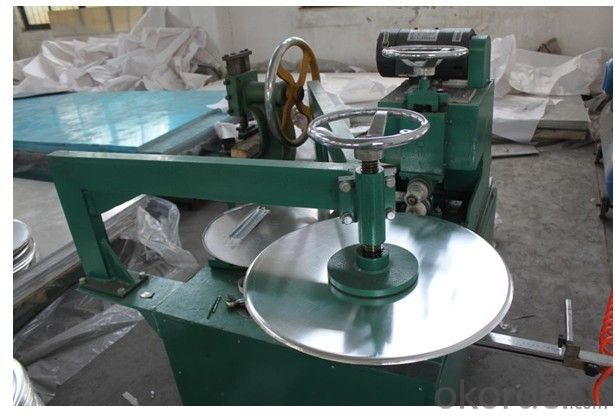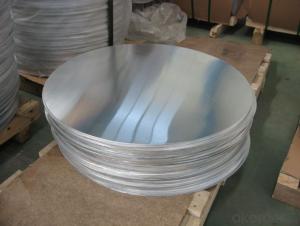0.05-4.0mm Thickness Aluminum Circle For Household
- Loading Port:
- Shanghai
- Payment Terms:
- TT OR LC
- Min Order Qty:
- 1 m.t.
- Supply Capability:
- 6000 m.t./month
OKorder Service Pledge
OKorder Financial Service
You Might Also Like
Item specifice
0.05-4.0mm Thickness Aluminum Circle For Household
Packaging & Delivery
| Packaging Details: | 25kg/carton-boxes(35*32*19CM) &Fumigation wooden-pallets (110*110*15cm) 20GP can loading 22 Ton,total 21 pallets,20 CBM. |
| Delivery Detail: | within 25 days |
Specifications
1).Excellent Surface Quality for lighting reflectors.
2).Excellent deep drawing and spinning quality.
3).Anodizing Quality
Aluminium circle/Aluminium discs/disks for cooking utensils Cookware
Aluminum disc Surface Finish: Bright & smooth surface, without flow lines, slightly oiled to avoid White rusting.Smooth,Brightly ,No Zone of Fracture ,No Scratched ,No oil Sludge
We enjoy a good reputation among our customers for our aluminum circle with high quality and competitive price, win high appreciation from our clients with the excellent workman-ship and professional ability. The quality matches with ISO 9001 quality management system.
It is equipped with 5 hot tandem rolling line, 4 cold mill production lines, 4 annealing surface machines and a complete finishing equipment.
Specification:
Alloy
Temper
Specification
Thickness
Diameter
1070,1050,3003,1100
O,H12,H14,H16
0.5-5.0mm
100-1200mm
Aluminum disc chemical Properties(WT.%)
Alloy
Si
Fe
Cu
Mn
Mg
Cr
Ni
Zn
Ca
V
Ti
Other
Min.A1
1050
0.25
0.4
0.05
0.05
0.05
-
-
0.05
-
0.05
0.03
0.03
99.5
1070
0.25
0.25
0.04
0.03
0.03
-
-
0.04
-
0.05
0.03
0.03
99.7
3003
0.6
0.7
0.05-0.2
1.0-1.5
-
-
-
0.1
-
-
-
0.15
96.95-96.75


- Q:Can aluminum sheets be used for air ducts?
- Yes, aluminum sheets can be used for air ducts. Aluminum is a commonly used material for air ducts due to its lightweight, durable, and corrosion-resistant properties. It is also easy to work with and can be easily shaped and formed to fit various duct designs.
- Q:Would a chemical reaction happen between a piece of copper and a liquid solution containing a compound of aluminum? Why or why not? FIRST BEST ANSWER GETS POINTS!
- Figure out the Eknots using a chart. Cu -- Cu2+ = Enot of ? Al3+ --- Al = Enot of ? It needs to be positive to spontaneously react. I believe from memory that Al -- Al3+ is 1.3volts, so the reverse is negative. Meanwhile Cu is something under .5 volts, so it won't be enough to make the reaction work. This is further understood because aluminum requires a lot of energy to smelt from the oxide (which is the reverse reaction of Al3+ -- Al that you're talking about here) Secondly, do your homework man, it's REALLY obnoxious to add the why or why not and phrase everything exactly as your homework asks. Try to ask a question about the topic so you actually learn. For example, what are reduction potentials in terms of, for example, Cu --- Cu2+
- Q:Are aluminum sheets suitable for electrical applications?
- Aluminum sheets are appropriate for electrical applications, as they possess numerous advantages. Primarily, aluminum is a highly conductive metal, which has led to its increasing popularity in electrical applications. Furthermore, its lightweight nature and exceptional heat dissipation properties make it an optimal choice for applications that necessitate efficient thermal management. This is particularly critical in electrical systems where heat generation occurs, including power transmission lines, electrical panels, and heat sinks. Moreover, aluminum sheets exhibit high resistance to corrosion. Unlike certain other metals, aluminum forms a protective oxide layer on its surface, preventing further oxidation and corrosion. This makes it a reliable option for electrical applications that are exposed to harsh environments or moisture. Additionally, aluminum is a cost-effective alternative compared to other metals frequently used in electrical applications, such as copper. It is easily obtainable and has a lower price point, making it appealing to both manufacturers and consumers. However, it is important to acknowledge that aluminum has lower electrical conductivity than copper. Consequently, for certain applications where high conductivity is essential, such as power transmission lines, copper may still be preferred. Nonetheless, advancements in technology and design have enabled aluminum to be effectively utilized in a wide range of electrical applications, encompassing wiring, connectors, bus bars, and transformers. In summary, aluminum sheets are indeed suitable for electrical applications, offering advantages like lightweight construction, exceptional thermal management, corrosion resistance, and cost-effectiveness. The ultimate determination of whether to employ aluminum or another material hinges on the specific requirements and limitations of the electrical application in question.
- Q:Can the aluminum sheets be used for manufacturing light reflectors?
- Yes, aluminum sheets can be used for manufacturing light reflectors. Aluminum is highly reflective and has excellent light reflecting properties, making it a popular choice for manufacturing light reflectors in various industries.
- Q:How to clean the engine oil and kerosene on the surface of aluminum sheet?
- you can buy a bottle of petroleum ether in chemical raw material shop, it will be clean after rubbing, or you can buy solvent oil.
- Q:Can aluminum sheets be roll-formed?
- Yes, aluminum sheets can be roll-formed.
- Q:There seems to be a load of buzz out there regarding the use of aluminum pots and pans. They apparently may cause Alzheimer’s or bone degeneration in women. I have some cast iron pans that I use when ever possible but they are not always practical. I’d like some of you kitchen pros to give me some sound advice regard the use of aluminum in the home kitchen. I know they are used in food service organizations.... I look forward to some informative replys.Thanks in advance.
- each thing you do in any given day would reason some style of maximum cancers. you may could be residing in a bubble to not be uncovered. of direction, the bubble could be produced from some style of plastic which of direction would desire to divulge you to 3 strand of maximum cancers besides.
- Q:What are the different bending methods for aluminum sheets?
- Aluminum sheets can be bent using different methods, each with its own advantages and limitations. Various bending techniques for aluminum sheets include: 1. Air Bending: By utilizing a punch and die, a bend is formed in the aluminum sheet without direct contact. Compressed air is employed to exert force on the sheet, resulting in the desired bend. Air bending is a versatile method that allows for a range of bend angles and radii. 2. Bottom Bending: This method involves clamping the aluminum sheet between a V-shaped die and a flat die. A punch is then used to press the sheet into the V-shaped die, creating the desired bend. Bottom bending is suitable for achieving sharp bends with small radii. 3. Coining: Precise and crisp bends are formed by applying high pressure to the aluminum sheet between a punch and a die. Coined bends exhibit minimal springback. However, this method requires specialized equipment and is typically utilized for high-volume production. 4. Roll Bending: By passing the aluminum sheet between a set of rollers, it is gradually bent into the desired shape. Roll bending is commonly employed for creating cylindrical or conical shapes. This technique can achieve large radii and is suitable for thicker aluminum sheets. 5. Press Brake Bending: This commonly used method employs a hydraulic or mechanical press brake to create bends in aluminum sheets. The sheet is clamped between a punch and a die, and the press brake applies force to create the bend. Press brake bending offers flexibility in terms of bend angles and radii. It is important to consider various factors such as the desired bend angle, radius, material thickness, and specific application requirements when selecting a bending method.
- Q:What keeps things colder- plastic wrap or aluminum foil?
- Aluminum foil. It is thicker, and metal retains heat/cold longer than the thin film of plastic would. I actually use both when I freeze things like lasagna...I use a layer of plastic wrap on it first, then a layer of foil over the top. It creates an extra (albeit fine) layer of insulation.
- Q:Can aluminum sheets be used for decorative panels?
- Yes, aluminum sheets can be used for decorative panels. Aluminum is a versatile and lightweight material that can be easily shaped, cut, and formed into various designs and patterns. It offers a sleek and modern appearance, making it a popular choice for decorative applications in both residential and commercial settings. Aluminum panels can be used for a wide range of purposes, including wall cladding, ceiling panels, room dividers, signage, and more. Additionally, aluminum is resistant to corrosion and weathering, making it suitable for both indoor and outdoor use. Furthermore, aluminum panels can be customized with different finishes, such as powder coating or anodizing, to enhance their visual appeal. Overall, aluminum sheets are an excellent choice for creating decorative panels due to their aesthetic appeal, durability, and versatility.
1. Manufacturer Overview |
|
|---|---|
| Location | |
| Year Established | |
| Annual Output Value | |
| Main Markets | |
| Company Certifications | |
2. Manufacturer Certificates |
|
|---|---|
| a) Certification Name | |
| Range | |
| Reference | |
| Validity Period | |
3. Manufacturer Capability |
|
|---|---|
| a)Trade Capacity | |
| Nearest Port | |
| Export Percentage | |
| No.of Employees in Trade Department | |
| Language Spoken: | |
| b)Factory Information | |
| Factory Size: | |
| No. of Production Lines | |
| Contract Manufacturing | |
| Product Price Range | |
Send your message to us
0.05-4.0mm Thickness Aluminum Circle For Household
- Loading Port:
- Shanghai
- Payment Terms:
- TT OR LC
- Min Order Qty:
- 1 m.t.
- Supply Capability:
- 6000 m.t./month
OKorder Service Pledge
OKorder Financial Service
Similar products
New products
Hot products
Hot Searches
Related keywords




























